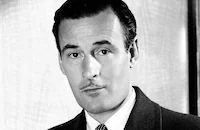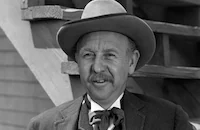The Falcon's Brother

Brief Synopsis
Cast & Crew
Stanley Logan
George Sanders
Tom Conway
Jane Randolph
Don Barclay
Cliff Clark
Film Details
Technical Specs

Synopsis
Gay Lawrence, the debonair sleuth known as "The Falcon," and his sidekick Lefty arrive at dockside to meet a Latin American cruise ship carrying Gay's brother Tom. In Tom's cabin, homicide inspector Timothy Donovan of the homicide informs Gay that his brother is dead, a victim of suicide. After Diane Medford, a shipboard companion of Tom's, offers Gay her sympathy, the sleuth instructs Lefty to follow her in their car. As they tail Diane, Gay announces that the corpse on the cabin floor was not his brother, nor was he a suicide victim. Gay tracks Diane to a fashion show at her employer Madame Arlette's salon, where she is greeted by her fiancé, fashion editor Paul Harrington. Also at the fashion show are two other passengers from the boat, Latin American dancers Carmela and Valdez, who request one of Arlette's designs. Before Gay can approach Diane, he is stopped by eager reporter Marcia Brooks. Finally dodging the inquisitive reporter, Gay follows Diane to her office, but as he steps in to interrogate her, a gunshot rings out and she keels over, dead. Although Gay sees the murder weapon lying beside Diane's body, he runs into the alley, where he bumps into his brother Tom and informs him of the murder. Just then Inspector Donovan, who has been following Gay, arrives at the scene and arrests Lefty for the crime. While on the trail of Diane's murderer, Gay steps into the street and is run down by a speeding car. Tom takes his unconscious brother to his apartment, where he is greeted by Marcia, who demands information about the murder. Tom convinces her to return the next morning and the following day, Lefty, who has been released with a suspended sentence, arrives at Gay's apartment and learns that his boss will soon regain consciousness. Marcia then informs Tom that the murder weapon is missing, prompting Tom to return to Arlette's to investigate. At the salon, Tom makes a date to meet Arlette at a nightclub and there informs her that the police have found the murder weapon and are tracing the serial number. Arlette abruptly bids the detective good night, calling Donovan with Tom's whereabouts before she leaves the club. After eluding the inspector once again, Tom and Lefty search Arlette's salon, where they find the gun hidden in a mannequin. When Donovan tracks them down at the salon, Tom introduces himself as Gay's brother, and the inspector arrests him for false impersonation. After proving his identity, Tom is freed and directs Marcia to investigate Harrington's photographer, Savitski. Tom then visits Arlette and, after showing her the gun, forces her to admit that she hid the weapon to protect Harrington, with whom she is in love. Confronted by his gun, Harrington denies murdering Diane and is exonerated by a ballistics expert. Just as they reach a dead end, Marcia discovers that Savitski is an illegal alien. As he is questioned by Lefty and Tom, Savitski is about to reveal a clue when he falls dead, knocking a pile of magazines off his desk. After determining that Savitski was killed by a poisoned cigar, Tom hears a noise outside the office and instructs Lefty to pose as the photographer. At that moment, Valdez and Carmela enter the office to threaten Savitski at gunpoint. When Tom steps out of the shadows, the pair identify themselves as Mexican counter-espionage agents and explain that Diane was killed because she knew too much. After notifying Donovan of Savitski's murder, the agents and Tom and Lefty disperse, and Tom carries the magazines back to Gay's apartment. Certain that Harrington is involved in the murders, Tom and Lefty scrutinize the magazines for a clue when Marcia arrives and notices that a magazine cover dated 7 December, the day that Pearl Harbor was bombed, was shot in Honolulu. Realizing that the covers reveal information about planned sabotage, Tom deduces that the next incident is to take place that day at a New England inn. Tom and Marcia speed off to New England, and just after they leave, Gay regains consciousness and he and Lefty proceed to New England, also. Tom and Marica find the small Eastern town populated by German agents, and after Tom recognizes the ballistics expert as one of the agents, Harrington orders them imprisoned at the base of a bell tower. Discovering that the agents plan to shoot a Latin American envoy as his plane lands, Tom struggles to reach the rope attached to the bell's clapper. Just then Gay drives up and as he argues with the agents, Tom begins to ring the bell, drawing Gay's attention to a machine gun aimed at the diplomat. Gay steps in front of the diplomat just as the gun cracks, sacrificing his own life for that of an ally. With the spy ring smashed, Tom is about to leave town when he receives a threatening phone call from a foreign sounding voice and decides to stick around.

Director
Stanley Logan
Cast

George Sanders

Tom Conway

Jane Randolph
Don Barclay
Cliff Clark
Edward Gargan
Eddie Dunn
Charlotte Wynters
James Newill

Keye Luke
Amanda Varela
George Lewis

Gwili Andre
Andre Charlot

Mary Halsey

Charles Arnt

Richard Martin
Julie Warren
Ken Harlan
Andre Marsaudon
John Dilson
Eddy Chandler
Jack Gargan
Tommy Tucker

Kay Aldridge
Georgia Carroll
Bonnie Kildare
Max Waizman
Perc Launders
Ralph Brooks
William Forrest
Carl Stockdale
Ann Summers
Manuel Paris
Louis Donath
Mickey Martin
Allen Wood
Marten Lamont
Crew
C. Bakaleinikoff
Clem Beauchamp
Claude E. Carpenter
Albert S. D'agostino
Maurice Geraghty
Walter E. Keller
Roy Meadows
Russell Metty
Stuart Palmer
Renie
Craig Rice
Mark Robson
Darrell Silvera
Roy Webb

Videos
Movie Clip



Film Details
Technical Specs

Articles
The Falcon's Brother
Sanders is joined in The Falcon's Brother by his real life brother Tom Conway. Conway, in a convenient bit of casting, plays Sanders' screen brother as well. The idea espoused by RKO was that by introducing Conway as Tom Lawrence, it could write Sanders out of the series and give viewers an acceptable Falcon replacement in his brother. But Sanders wasn't taking any chances on being asked back he insisted that his character be killed off in the film.
And to hear producer Maurice Geraghty tell it, Sanders was smart to question the studio's motives. "RKO was very anxious to have Sanders continue in the Falcon series," Geraghty said. "But their pleading fell on deaf ears. Then one of the bright, front-office executives got the idea of offering to co-star George's brother, Tom Conway, just to get another picture out of George. They gave George a glowing picture of how it would make a star of his brother, but actually they had no such intentions. They just wanted another picture from Sanders."
The two brothers, who were born in St. Petersburg, Russia to English parents, both got their start acting on stage and radio in England. When they decided to give Hollywood a go, they reportedly flipped a coin to see who would get to keep the name Sanders. It was actually Conway who was signed first to a studio contract after Sanders refused a meeting with MGM's Louis B. Mayer. But Sanders soon outpaced his brother's head start. By 1942, when The Falcon's Brother was made, Sanders had not only starred in five Saint movies (including The Saint Strikes Back (1939) and The Saint in London [1939]), but he'd also received third billing in the Norma Shearer vehicle Her Cardboard Lover (1942) and had a significant role in Alfred Hitchcock's Foreign Correspondent (1940).
Conway's work, however, had mainly been limited to small parts in films like Free and Easy (1941) and Grand Central Murder (1942). Certainly the difference in the brothers' career progress was reflected in their pay for The Falcon's Brother. Sanders got around $14,000 for his final turn as the Falcon. While Conway received only his contract salary he and the other stock players totaled a combined cost of $2500.
Along with their career paths, the brothers also apparently had very different personalities. Geraghty (who went on to produce eight Falcon films) recalled working with each of them:
"George had personality. He was extravagant. He loved parties on yachts. He had a certain giggle. George once said he sold his yacht because he preferred being a guest to being a host."
"Tom was different. He was one-dimensional, but full of overtones and undertones. He was self-conscious, shy. But when the series became more popular, it went to his head. He thought he was the series and the only reason for its success."
It's easy to see where Conway got this idea. To RKO's surprise, Conway's Falcon films were more popular than his brother's. And he would go on to make nine more entries his last in the series would be The Falcon's Adventure (1946). While at RKO, Conway also appeared in the Val Lewton horror classics Cat People (1942) and I Walked with a Zombie (1943). But he would be forever typecast by his Falcon role. After his run as the Falcon ended, Conway would be cast as detective Bulldog Drummond in two films, The Challenge and 13 Lead Soldiers (both 1948) and would play detectives The Saint and Sherlock Holmes on radio as well. Sanders, on the other hand, had moved on to bigger things like winning an Oscar for Best Supporting Actor for All About Eve (1950). And though the brothers had a falling out in later years, they did team up on screen one more time. Conway once again appeared as Sanders' brother in 1956's Death of a Scoundrel.
Producer: Maurice Geraghty
Director: Stanley Logan
Screenplay: Stuart Palmer, Craig Rice, Michael Arlen (characters)
Cinematography: Russell Metty
Film Editing: Mark Robson
Art Direction: Albert S. D'Agostino, Walter E. Keller
Music: Roy Webb
Cast: George Sanders (Gay Lawrence), Tom Conway (Tom Lawrence), Jane Randolph (Marcia Brooks), Don Barclay (Lefty), Cliff Clark (Inspector Timothy Donovan), Edward Gargan (Detective Bates).
BW-63m.
by Stephanie Thames

The Falcon's Brother
Quotes
Trivia
Originally intended to be the last of the "Falcon" movies, as 'Sanders, George' wanted out of the series.
Notes
This film marked George Sanders' last appearance as Gay Lawrence, "the Falcon." According to a pre-production news item in Hollywood Reporter, Sanders, who was on loan from Twentieth Century-Fox, wanted out of the series after completing his four-picture commitment to RKO. Although the RKO asked Sanders to continue, he preferred to work on "A" productions. To carry on the series, Tom Conway, who was Sanders' real-life brother, was introduced in this film as Gay's brother Tom. This picture also marked the first associate producer assignment for former writer Maurice Geraghty. For further information about the series, consult the Series Index and for The Gay Falcon.














